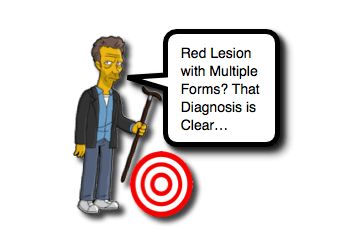Erythema Multiforme in Children

Erythema Multiforme: Basics
- Erythema multiforme is the skin manifestations of an acute immune-mediated reaction.
- The immune-mediated reaction is often triggered by:
- Viral infection – Majority of cases.
- HSV infection
- Mycoplasma pneumonaie
- Medications
- In children, medications are more closely related to SJS and TEN.
- Adults have a stronger association of EM with medications.
- Immunization [Read, 2015]
- Erythema multiforme is typically self-limited.
- Often it is considered to be on the spectrum that includes Stevens-Johnson Syndrome (SJS) and Toxic Epidermal Necrolysis (TEN), but…
- Current classification distinguish EM from this specific spectrum. [Bastuji-Garin, 1993]
- Erythema Multiforme differs from SJS, SJS-TEN Overlap, and TEN in: [Auquier-Dunant, 2002]
- Demographic characteristics
- Risk factors
- It is not associated with HIV infection, cancer, or collagen vascular diseases.
- It has less of an association with medications.
Erythema Multiforme: Mimics
- Erythema multiforme in children is often misdiagnosed. [Read, 2015; Léauté-Labrèze, 2000]
- Target lesions are NOT pathognomonic for erythema multiforme. [Read, 2015]
- There are several other conditions that need to be considered when evaluating target lesions:
- Serum Sickness
- Kawasaki Disease
- HSP
- Lupus Ertyhematosus
- Urticaria multiforme
- Often mistaken for erythema multiforme. [Read, 2015]
- Acute urticaria that are annular and polycyclic wheals
- Have central clearing and ecchymotic centers
- Typically start as small macules or papule and then evolve to various sizes.
- Individual lesions fade within 24 hours.
- NOT fixed to the extremity distribution like EM is.
- Involves trunk, face, and extremities.
- Patient may also have pruritus, angioedema, and/or dermatographism (which is pretty interesting to see).
- Often mistaken for erythema multiforme. [Read, 2015]
Erythema Multiforme: Diagnosis
- The classification criteria for EM are based on Bastuji-Garin, 1993.
- When observing lesions, consider location and document what you see… don’t just say “target lesions”… make note of all characteristics when able (something I am terrible at).
- EM Minor
- Epidermal detachment < 10% BSA
- Acrally distributed lesions (acral = extremities, ears, peripheral parts)
- Can be typical or raised atypical or combination of lesions
- Typical Target Lesions = <3cm diameter, symmetric, round, well-defined border, and 3 concentric color zones
- RAISED Atypical Target Lesions = <3 cm diameter, round, poorly defined border, only 2 concentric color zones.
- No mucosal involvement
- EM Major is the same as EM minor but has one or more mucosal surface involved.
- SJS and TEN
- Lesions are different:
- Flat, atypical target lesions or
- Widespread macules
- Amount of Epidermal detachment determines classification
- SJS has <10% BSA
- SJS/TEN Overlap has 10% – 30% BSA
- TEN has >30% BSA
- Lesions are different:
- EM Minor
Erythema Multiforme: Management
- Treatment is supportive.
- Symptomatic care with antipyretics and antihistamines can help.
- There have been reported concerns that NSAIDs may worsen the condition. [Dore, 2007]
- If there is a clear association with a medication, cessation of that is warranted.
- Majority of children with erythema multiforme are able to be discharged and managed as outpatients. [Read, 2015]
Moral of the Morsel
- Distribution matters. If it involves more than the extremities, think twice about calling it erythema multiforme.
- Not all target lesions are the same. Flat, atypical targets are not consistent with EM.
- Think about urticarial multiforme. Just another odd condition to keep in mind to ensure we are not misclassifying illnesses.
- Think worse first! Look for the mucosal membrane involvement closely!
References
Read J1, Keijzers GB. Pediatric Erythema Multiforme in the Emergency Department: More Than “Just a Rash”. Pediatr Emerg Care. 2015 Nov 9. PMID: 26555305. [PubMed] [Read by QxMD]
Keller N1, Gilad O1, Marom D1, Marcus N1, Garty BZ1. Nonbullous Erythema Multiforme in Hospitalized Children: A 10-Year Survey. Pediatr Dermatol. 2015 Sep-Oct;32(5):701-3. PMID: 26223537. [PubMed] [Read by QxMD]
Moreau JF1, Watson RS, Hartman ME, Linde-Zwirble WT, Ferris LK. Epidemiology of ophthalmologic disease associated with erythema multiforme, Stevens-Johnson syndrome, and toxic epidermal necrolysis in hospitalized children in the United States. Pediatr Dermatol. 2014 Mar-Apr;31(2):163-8. PMID: 23679157. [PubMed] [Read by QxMD]
Emer JJ1, Bernardo SG, Kovalerchik O, Ahmad M. Urticaria multiforme. J Clin Aesthet Dermatol. 2013 Mar;6(3):34-9. PMID: 23556035. [PubMed] [Read by QxMD]
Dore J1, Salisbury RE. Morbidity and mortality of mucocutaneous diseases in the pediatric population at a tertiary care center. J Burn Care Res. 2007 Nov-Dec;28(6):865-70. PMID: 17925657. [PubMed] [Read by QxMD]
Forman R1, Koren G, Shear NH. Erythema multiforme, Stevens-Johnson syndrome and toxic epidermal necrolysis in children: a review of 10 years’ experience. Drug Saf. 2002;25(13):965-72. PMID: 12381216. [PubMed] [Read by QxMD]
Auquier-Dunant A1, Mockenhaupt M, Naldi L, Correia O, Schröder W, Roujeau JC; SCAR Study Group. Severe Cutaneous Adverse Reactions. Correlations between clinical patterns and causes of erythema multiforme majus, Stevens-Johnson syndrome, and toxic epidermal necrolysis: results of an international prospective study. Arch Dermatol. 2002 Aug;138(8):1019-24. PMID: 12164739. [PubMed] [Read by QxMD]
Léauté-Labrèze C1, Lamireau T, Chawki D, Maleville J, Taïeb A. Diagnosis, classification, and management of erythema multiforme and Stevens-Johnson syndrome. Arch Dis Child. 2000 Oct;83(4):347-52. PMID: 10999875. [PubMed] [Read by QxMD]
Kelly JP1, Auquier A, Rzany B, Naldi L, Bastuji-Garin S, Correia O, Shapiro S, Kaufman DW. An international collaborative case-control study of severe cutaneous adverse reactions (SCAR). Design and methods. J Clin Epidemiol. 1995 Sep;48(9):1099-108. PMID: 7636511. [PubMed] [Read by QxMD]
Bastuji-Garin S1, Rzany B, Stern RS, Shear NH, Naldi L, Roujeau JC. Clinical classification of cases of toxic epidermal necrolysis, Stevens-Johnson syndrome, and erythema multiforme. Arch Dermatol. 1993 Jan;129(1):92-6. PMID: 8420497. [PubMed] [Read by QxMD]



thank you for your great work . it helped me a lot
Are you a Paediatric dermatologist?
NO, I am not.
Good work Sean Fox, your work is exemplary…..
I appreciate the appreciation!
Thank you!